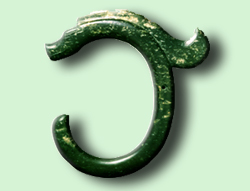The famous Jade Dragon, unearthed in the Inner Mongolia Autonomous Region in 1971, is one of the representative works of China's early jade carving crafts. And, it is the earliest dragon carved from jade in China up till now.

The Jade Dragon twisted its body to a half circle and is 26 cm in height as a whole. The dragon, in a flying posture, does not have horns, squamas or feet and presents characteristics of primitive dragon images. The work is now kept inthe National Museum of Chinese History.
The image of dragon comes from ancient people's worship for totem and it represents power and hope. Therefore, later emperors in ancient China tried to apotheosize themselves with the image of dragons, and dragons had a very high position in the eyes of Chinese people. After thousands of years, dragons became the symbol of the Chinese people, who pin high hopes on dragons for good life and bright future. Though designed simply, this piece of jade article demonstrates artistic characteristics of simplicity and plainness of China's jade carving craft in the early period.










